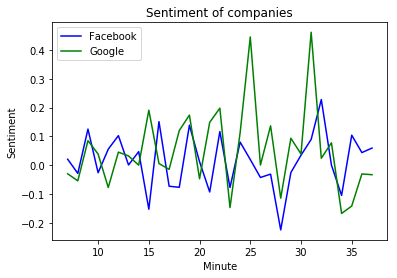Sentiment analysis
Analyzing Social Media Data in Python

Alex Hanna
Computational Social Scientist
Understanding sentiment analysis
- Method
- Counting positive/negative words in the document
- Assessing positivity/negativity of the whole document
- Uses
- Analyzing reactions to a company, product, politician, or policy
Sentiment analysis tools
- VADER
SentimentIntensityAnalyzer()- Part of Natural Language Toolkit (
nltk) - Good for short texts like tweets
- Measures sentiment of particular words (e.g. angry, happy)
- Also considers sentiment of emoji (😀) and capitalization (Nice vs NICE)
- Part of Natural Language Toolkit (
Implementing sentiment analysis
from nltk.sentiment.vader import SentimentIntensityAnalyzersid = SentimentIntensityAnalyzer()sentiment_scores = tweets['text'].apply(sid.polarity_scores)
Interpreting sentiment scores
- Reading tweets as part of the process
- Does it have face validity? (i.e. does this match my idea of what it means to be positive or negative?)
Interpreting sentiment scores
tweet1 = 'RT @jeffrey_heer: Thanks for inviting me, and thanks
for the lovely visualization of the talk! ...'
print(sid.polarity_scores(tweet1))
{'neg': 0.0, 'neu': 0.496, 'pos': 0.504, 'compound': 0.9041}
tweet2 = 'i am having problems with google play music'
print(sid.polarity_scores(tweet2)
{'neg': 0.267, 'neu': 0.495, 'pos': 0.238, 'compound': -0.0772}
Generating sentiment averages
sentiment = sentiment_scores.apply(lambda x: x['compound'])sentiment_fb = sentiment[check_word_in_tweet('facebook', tweets)] .resample('1 min').mean() sentiment_gg = sentiment[check_word_in_tweet('google', tweets)] .resample('1 min').mean()
Plotting sentiment scores
plt.plot(
sentiment_fb.index.minute,
sentiment_fb, color = 'blue'
)
plt.plot(
sentiment_g.index.minute,
sentiment_gg, color = 'green'
)
plt.xlabel('Minute')
plt.ylabel('Sentiment')
plt.title('Sentiment of companies')
plt.legend(('Facebook', 'Google'))
plt.show()

Let's practice!
Analyzing Social Media Data in Python

